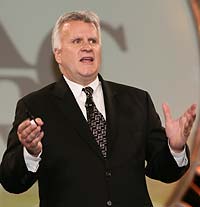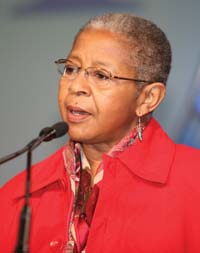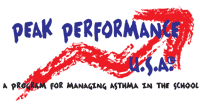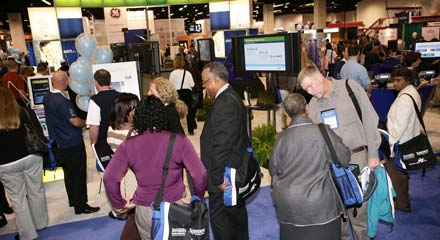
![]()

![]()
Congress Gazette
Sunday, December 14, 2008
Keynote Address emphasizes “stop the bleeding… start the healing”

Timothy McDonald
Timothy B. McDonald, MD, JD, presented the AARC Keynote Address Saturday, Dec. 13, to an audience of more than 2,000 respiratory care professionals at the AARC Congress in Anaheim, CA.
As chief safety and risk officer for health affairs at the University of Illinois at Chicago, Dr. McDonald oversees a disclosure program that has increased safety for patients and reduced the number of malpractice suits. His presentation, “Legal and Ethical Pitfalls in Respiratory Care,” offered information and encouragement aimed at changing the culture in health care to support effective ways to report, investigate, communicate, take responsibility, and resolve patient safety issues.
Dr. McDonald emphasized that the respiratory therapist is a valuable member of the health care team and, armed with special expertise in respiratory care, can provide crucial input in patient risk and safety matters. We must “stop the bleeding and start the healing,” he said, noting that families of patients harmed by safety violations generally appreciate the opportunity to communicate safety concerns. They want the facility to correct problems so that other patients will not be harmed by the same unsafe practice.
The AARC’s 2008 Keynote Address was supported by an unrestricted educational grant from GE Healthcare.
AARC installs officers and directors for 2009

2009 AARC officers, directors, and delegates were sworn in at the AARC Annual Business Meeting.
The Association’s 2009 officers, directors, and House of Delegates officers were installed this morning during the AARC Annual Business Meeting. Reports were presented by the AARC president, treasurer, and executive director, along with the ARCF, House of Delegates, and Board of Medical Advisors. (Read the president’s and treasurer’s reports in this section.)

Toni Rodriquez
The Annual Meeting also featured the presidential address by Toni Rodriguez, EdD, RRT. “I have been blessed to represent one of the most dynamic professions in the world at the time of its greatest achievement,” she said, listing a number of advancements the profession has made [see president’s report below]. “As I leave my term as president,” she concluded, “I am confident in the future of my profession.”
Newly elected officials were also installed, including: Timothy R. Myers, BS, RRT-NPS, 2009–2010 AARC president; and Karen Stewart, MSc, RRT, FAARC, secretary/treasurer; George Gaebler, MSEd, RRT, FAARC, vice president of internal affairs; and Joseph Lewarski, BS, RRT-NPS, FAARC, vice president of external affairs. The following are joining the Board of Directors: Debbie Fox, MBA, RRT-NPS; Doug McIntyre, MS, RRT, FAARC; John Lindsey, Jr., MEd, RRT-NPS; and Michael Tracy, BA, RRT-NPS.
The chairs-elect of the following specialty sections also took office: Long Term Care: Gene Gantt, RRT; Management: Douglas Laher, MBA, RRT; and Surface and Air Transport: Steven Sittig, RRT-NPS, FAARC.
2008 AARC Executive Reports
President’s Report
by Toni Rodriguez, EdD, RRT

Toni Rodriquez
As I close the chapter on the first 2-year presidency for the AARC, I am thankful for the experience. I have been blessed to represent one of the most dynamic professions in the world at a time of its greatest achievements. Upon review, you will agree that as an Association we have been extremely busy and effective. Thank you for the opportunity to serve as your President. The top 10 events and/or accomplishments of my presidency are as follows:
- The 60th anniversary of the AARC:
Formed 60 years ago in Chicago, IL, the AARC has not only survived but thrived. It has been an honor to lead an organization with the grit, vigor, and tenacity to accomplish so much so early in its lifespan. By all reliable indicators, the best is yet to come! - Respect as an expert on policy and legislative initiatives related to the care of cardiopulmonary patients:
Due to our solid reputation, comments from the AARC are not only solicited and well received but adopted by organizations such as CMS, FDA, JCAHO, CDC, and various Local Medicare Regional Policy organizations. - Registered respiratory therapists with a minimum of a baccalaureate degree become eligible to become commissioned officers in the U.S. Public Health Service.
For the first time, a branch of the federal government has acknowledged that respiratory therapists, by virtue of their education, training, and professionalism are worthy of officer status. What a thrill for this to happen on my watch. - Respiratory Care in 2015 and Beyond:
We initiated the process to define the role of the respiratory therapist in light of future health care trends and to determine an effective strategy for achieving success as a profession. What a legacy. - Growth of our international presence:
Since 1990, more than 110 International Fellows from over 50 different countries and an International Council for Respiratory Care that represents 19 countries confirm the AARC’s commitment to the globalization of our profession. Our international influence continues to grow through international speaking engagements, increasing international membership, translations of our educational resources and podcasts into foreign languages, a larger number of foreign submissions to our Journal, and re-publication of our Journal articles in foreign publications. - Passage of the Pulmonary and Cardiac Rehabilitation Act:
For over 20 years the AARC and other organizations supporting pulmonary health have attempted to have a consistent, clear national coverage policy for pulmonary rehabilitation issued under the Medicare program. That 20-year dream was realized this year. - Membership tops 48,000 members:
Membership in the AARC now tops 48,500 members. At the start of my presidency, membership was only 43,000. This is an 11% increase! - Formation of 5 new roundtables:
As evidence of our expanding scope of practice, we have established 5 new roundtables at the request of our membership over the last two years to include, Moderate Sedation, Military, Research, Neuromuscular, and Tobacco-Free Lifestyle. - Successful partnerships with patient information and advocacy groups:
The success of the Mobil Spirometry Unit, with over 20,000 people screened for COPD during the last 2 years, is just 1 example of our successful collaboration with such organizations as the COPD Foundation, NHLBI, Alpha 1 Foundation, and NLHEP. - The Medicare Respiratory Therapy Initiative:
Introduction of this landmark legislation would revise the Medicare Program to permit certain highly qualified respiratory therapists to provide a variety of respiratory therapy services to Medicare patients without the physician having to physically be in the office. When this legislation is enacted, a new day will dawn on patient access to respiratory therapists.
Secretary-Treasurer’s Report
by Colleen Schabacker, BA, RRT, FAARC
In 2008, a global economic crisis was suggested by several important indicators of economic downturn worldwide. These included high oil prices, which led to both high food prices and global inflation; a substantial credit crisis leading to the bankruptcy of large and well established investment banks as well as commercial banks in various nations around the world; increased unemployment; the melt down on Wall Street; and the possibility of a global recession.
However, rest assured, your AARC remains financially sound.
- In late 2007 the mortgage on our building in Irving, TX, was paid in full.
- With the economic downfall, we have witnessed a slight decrease in revenues from product sales, educational offerings, and publications as would be expected.
- As with other businesses who have invested in the stock market, the AARC has experienced some major losses; but on the other hand, our dividend income has pretty much compensated for those losses.
- Our membership continues to increase. The major reason the AARC remains a shining star in the world’s financial crisis is because of its members. That’s right, it’s because of you. It’s because with your help and support, our membership rose above 48,000 members in October of this year. It’s because you believe in professionalism, you want to be the best there ever was and you believe being a member of your professional organization is one of the steps to doing that. It’s because you keep asking for quality products, peer-reviewed literature, and educational offerings by experts, and the AARC continues to meet your demands. That’s right, it’s because of you.
I can’t express in words how gratifying it has been to serve as your Secretary/Treasurer this year. I would like to thank each and every one of you for going beyond where you thought you could go and for making this year such a huge success.
The Cardiopulmonary Physiology of Dinosaurs
This year’s 35th Donald F. Egan Scientific Memorial Lecture, “The Cardiopulmonary Physiology of Dinosaurs,” will be presented Sunday morning by David J. Pierson, MD, FAARC, editor emeritus of the Respiratory Care journal.
Dr. Pierson will present a serious but entertaining examination of dinosaurs, using evidence from paleontology, comparative physiology, and the ICU to appreciate the circulatory and respiratory physiology of Earth’s largest animals.
The Egan Lecture is supported by an unrestricted educational grant from GE Healthcare.
Key presentations provide Congress attendees with vital information
What are attendees learning at the Congress? These key lectures provide a great example of the cutting-edge topics covered during the meeting:
The AARC’s 24th Annual New Horizons Symposium will provide a critical review of “Neonatal Respiratory Care,” co-chaired by Peter Betit, RRT-NPS, FAARC, and Steven M. Donn, MD, on Sunday, Dec. 14, from noon to 5 pm. Eight lectures are scheduled, including “Oxygen Therapy Techniques in the Neonate,” “Surfactant Replacement Therapy,” “Bronchopulmonary Dysplasia,” and many more.
Richard M. Kallet, MS, RRT, FAARC, will present the 24th Phil Kittredge Memorial Lecture titled “What Is the Legacy of the NIH ARDS Net?” This special session, named after former Respiratory Care editor Phil Kittredge, will be offered 8:30 Monday morning and will offer an insider’s view of the workings of the network and its expected long-term impact on critical care research. Don’t miss this insightful look at the major breakthroughs of the ARDS Net, its place in medical history, its accomplishments, and, yes, even its controversies.
Thanks to ARCF reviewers!
by Steven Nelson, MS, RRT, FAARC, AARC Associate Executive Director
Every year, the American Respiratory Care Foundation (ARCF) presents multiple awards during the Awards Ceremony at the AARC Congress, and the whole process depends on a group of people who never get noticed: the educators who help review all of the applications that come in each year. We have a core group who have done a great job for the last several years, and I wanted to take this opportunity to thank them for their assistance. Without them, we would not be able to dig through the piles of personal essays and scientific papers that are submitted for the awards:
- Jeff Ward, MEd, RRT, University of Minnesota/Mayo Program in Respiratory Care
- Dennis Wissing, PhD, RRT, CPFT, AE-C, LSU Health Sciences Center, Shreveport
- Linda Van Scoder, EdD, RRT, Clarian Health & Affiliated Universities
- Pat Munzer, DHSc, RRT, Washburn University
- Thomas Barnes, EdD, RRT, FAARC, Northeastern University
- Sharon Hatfield, MBA, RRT, Jefferson College of Health Sciences
- John Zamjahn, PhD, RRT, LSU Health Sciences Center, New Orleans
- Jeffery Ludy, EdD, RRT, University of Central Florida
- Ray Sibberson, MS, RRT, FAARC, University of Akron
- James Woods, MS, RRT, RPFT, Florida Community College
- Doug Gardenhire, RRT-NPS, Georgia State University
Organize your Exhibit Hall experience
The Exhibit Hall at any AARC Congress can be overwhelming—so much to see, so much to do, so many vendors to visit.
Making sure you go home with what you came for takes a little organization, so here are a few tips we believe will help everyone make the most of this key Congress experience:
- Dedicate time each day to visit the Exhibit Hall.
- Make a list of the vendors you want to see, then divide up the list over the 3 days the hall is open. Don’t try to see everything all at once.
- Talk to exhibitors and ask them to share the scientific evidence on their new products and services. Ask about opportunities to conduct joint studies and investigations.
- Quickly discover the vendors who carry the products you want to see by looking in the Products & Services section of the AARC Buyer’s Guide, which you will find available at the AARC Information Center in the center of the Exhibit Hall.
- Find out about vendor-sponsored events during the Congress and take advantage of these great opportunities to learn more about the latest technology.
- Earn extra CRCEs at special exhibitor sessions.
- Be sure to request follow-up calls or visits from vendors after the Congress.
Remember it’s all a Buying Show as well. You can make deals right on the Exhibit Hall floor, often with special discounts just for Congress attendees. In fact, many attendees end up covering the cost of their trip solely through the savings they realize from these onsite transactions.
So get your plan down in writing and set it in motion. The hall will be open Saturday, Sunday, and Monday, 11 am–4 pm.
Peak Performance USA is back!

Peak Performance USA was a big hit back in the 1990s, when hundreds of AARC members used the program’s pre-packaged materials to go into their local schools and educate teachers, school nurses, and other personnel about managing asthma in alignment with the national asthma guidelines.
Now Peak Performance is back, and this time it is entirely based on the Internet. It can be found at www.PeakPerformanceUSA.info. Each school that participates in PPUSA will receive a complimentary peak flow meter and valved holding chamber. We thank Monaghan Medical, Lupin Pharmaceuticals, and Forest Laboratories, who provided an unrestricted grant making this possible.
Congress attendees are invited to the AARC Information Center in the Exhibit Hall today, where Tom Kallstrom, AARC COO, will provide more details about Peak Performance USA.
Congress safety tips
If you’re like most attendees at this year’s Congress, you came for the wealth of information that will be presented and the chance to network with peers from all over the country. Unfortunately, there are some other people lingering around this year’s meeting with an entirely different agenda. Large professional gatherings in major metropolitan areas may attract thieves and con men, and the savvy conventioneer will put security at the top of the list. Here are some common-sense ideas:
- Don’t wear your badge outside of the convention center.
- Watch out for any thieves who try to distract you by dropping coins, spilling something on your clothing, etc.
- Take care when entering or exiting cabs or other vehicles, particularly when loading/unloading baggage.
- Keep your eye on your belongings when talking on the phone (cell or pay) or waiting for a cab or other transportation. Don’t be distracted when in large groups of colleagues.
- Protect your calling card number from view when using a pay phone by shielding the phone with your body when you dial.
- Don’t reveal your hotel room number in crowded places where it might be overheard by the wrong person.
- Keep carry-on valuables (particularly high-dollar items such as lap-top computers) in sight at all times when traveling by air.
- Say “no thank-you” to passersby who offer to help carry and/or watch your possessions.
- Beware of limo drivers who pull up to the curb and offer you a discount on transportation. Use only licensed transportation services.
- Always carry your wallet in a front pocket and your purse with the flap toward your body.
- Do not carry large amounts of cash.
- Be sure to have the name, address, and phone number of an emergency contact person with you in case of an accident or sudden illness.
- Use hotel lock boxes for all valuables. Don’t leave them in your room.
- If car trouble arises on the trip to or from the airport, be sure to protect your luggage by locking the vehicle before seeking assistance.
- We are not expecting an earthquake, but since many of our attendees are unfamiliar with safety issues in earthquake zones, here is some practical advice: If inside, drop to the floor under a strong table or against an interior wall. Avoid windows and hanging objects. Cover your head and neck with your arms. Hold on until shaking stops.
Advances in Bronchoscopy
By Charles McArthur, BA, RRT, RPFT
There have been many recent innovations in the field of interventional bronchoscopy, according to Dr. Eric Edell, director of interventional pulmonary at the Mayo Clinic in Rochester, MN. In a talk delivered today, Dr. Edell reviewed new methods for the treatment of endobronchial disease and endobronchial obstruction. Techniques like autofluoresence bronchoscopy can identify early cancers before they are apparent during routine visualization. Navigational bronchoscopy combines bronchoscopy with other imaging techniques to more precisely obtain tissue samples. Endobronchial ultrasound (EBUS) has been developed to improve the yield of mediastinal lymph node sampling.
Lois Rowland, RRT-NPS, RPFT, respiratory care clinical coordinator at CJW Medical Center in Richmond, VA, followed Dr. Edell with a presentation describing the role of the respiratory therapist assistant during EBUS at her hospital, where two respiratory therapists assist during EBUS procedures. Rowland described the training involved to begin an EBUS program. The therapists must not only learn the EBUS technology, they must also learn about specimen preparation and handling. Respiratory therapists monitor the sample catheters for signs of bleeding as well, and must w ork closely with the interventional bronchoscopists to ensure a safe procedure for the patient.
Roving Reporter:
Goal-directed therapy in pediatric transport setting
by Steve Sittig, RRT-NPS, FAARC
Those in attendance for this Saturday afternoon presentation were treated to an outstanding lecture on goal directed therapy; specifically, how it relates to recognition and treatment of pediatric shock.
Richard A. Orr, MD, stated that pediatric shock is often under-recognized and can often be misclassified as respiratory distress. He went on to discuss that recognition and early treatment significantly reduces mortality in these patients. Case presentations reinforced the topic. Especially interesting was a video of an unresponsive infant with severe shock. Within minutes of receiving the needed fluid boluses, the child began to respond and interact with his surroundings.
